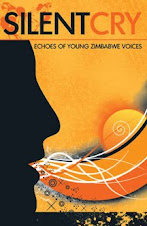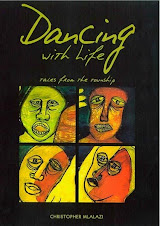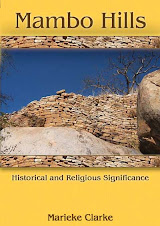Getting through the 1990s
Thursday, December 18, 2025
Ignatius T. Mabasa's The Mad reviewed by Pat Brickhill in the Zimbabwe Review
Getting through the 1990s
Sunday, November 23, 2025
John Eppel at the Bulawayo Book Club
Saturday, October 25, 2025
Mabasa, Vazhure carry Zimbabwean art to the world
Elliot Ziwira's article in The Herald on the launch of Ignatius Mabasa's The Mad and the opening of Samantha Vezhure's exhibition Nzwisa.
https://www.heraldonline.co.zw/mabasa-vazhure-carry-zimbabwean-art-to-the-world/
The Mad is co-published in Zimbabwe and the United Kingdom by amaBooks Publishers and Carnelian Heart Publishing.
Copies of the book are available in Zimbabwe through Book Fantastics (contact through @bookfantastics on Instagram, or @Book_Fantastics on X) and in the UK through Amazon (https://www.amazon.co.uk/Mad-Ignatius-T-Mabasa/dp/1914287967/) or through carnelianheartpublishing.co.uk. It will be available next year in North America through the University of Georgia Press.
Monday, October 20, 2025
Ignatius Mabasa nominated for the 2026 Astrid Lindgren Memorial Award for Storytelling
Renowned Zimbabwean author and storyteller
Ignatius Mabasa has been nominated for the 2026 Astrid Lindgren Memorial Award for storytelling.
The Astrid Lindgren Memorial Award is an international children's literary award established by the Swedish government in 2002 to honour the Swedish children's author Astrid Lindgren (1907–2002) and to promote every child's right to great stories. This global award is given annually to a person or organisation for their outstanding contribution to children's and young adult literature.
The prize is five million SEK (about US$500,000), making it the richest award in children's literature and one of the richest literary prizes in the world.
Tuesday, October 14, 2025
Photos from the Launch of 'The Mad'
Celebrating the Launch of Ignatius Mabasa' s ‘The Mad’
Reproduced from https://munyori.org/2025/10/mad-about-mabasa-a-celebration-of-the-mad/
by Beaven Tapureta
In the cool evening of October 10 a gathering of ‘the mad’ writers, publishers, artists, arts journalists, academics, friends and family enjoyed the memorable official launch of The Mad, a newly co-published English translation of Ignatius T Mabasa’s 1999 Shona novel Mapenzi, a classic.
A charming mood prevailed at the National Art Gallery of Zimbabwe as mbira songbird Hope Masike livened up the event with her spiritually powered music.
Although the waiting for the new baby is now over, the story behind it is of a devoted team of ‘doctors’ that withstood the hiccups yet cherished some positive experiences in its process of birth.
Guest speaker Aaron Chiundura Moyo, who is a renowned writer, playwright and actor, left everyone in stitches as he congratulated The Mad author Mabasa for drawing a crowd of ‘the mad’ in the room.
Speaking after Mabasa’s wife, Conelia, had told of how the Mapenzi draft manuscript became Ignatius’ ‘bait’ to win her love, Chiundura Moyo said artists in their budding years generally do that. One can imagine the young Mabasa walking up to the girl with that special ‘I am-a-writer-babe’ pride, flashing the manuscript in front of her like a sweetener, giving his all for love.
But Mrs. Mabasa’s story reminded Chiundura Moyo of a time he also once lured and excitedly shared one of his manuscripts with a girl who never returned it. Nobody knows if she read it and worse still, she never mentioned she loved him too!
Chiundura Moyo went on to touch on very serious issues pertinent to the business of translation, warning that in the absence of a clear cultural understanding of the original language, translators may kill our literature instead of promoting it globally.
Though the needs of non-Shona speakers must be considered, the translated version must have oneness of the original aura, the intrinsic value of the original language, he said.
He applauded Mabasa for his commitment to the preservation of African culture through language and Joyce Tsitsi Mutiti, The Mad translator for demonstrating that translation is not completely an academic exercise but also an activity done out of passion.
The major challenge generally faced by translators is how best a translated book, targeting a new audience, can balance with the inspiration that produced the original. Writers or artists are known to have personal habits in their work of creating. These habits are inseparable to their creations, they are a part of the unwritten context.
Indeed, a translator is not a re-writer, yet, without certain knowledge, some contextual meanings are lost when word-by-word translation is unnecessarily stuck to.
For instance, said Chiundura Moyo, an owl (zizi in Shona) could have considerable symbolical meaning when viewed from an African viewpoint whereas for a foreign audience, it’s simply a bird.
Culture, however, he said, should not be a limitation for translators, only that a certain alertness of the original purpose is demanded of those involved in the translation.
For writer and publisher Samantha Vazhure (Carnelian Heart Publishing Ltd), it was a great honour to be asked by the long-established amaBooks to co-publish The Mad with them.
Ignatius Mabasa could not help introducing himself to the gathering through a gripping story from his next novel which he said is titled Death of a Storyteller.
He re-traced the path Mapenzi has walked since the days he authored it when he was a student growing among ‘the radicals’ at the University of Zimbabwe.
His reflection of Mapenzi’s ups and downs, before and after it was published, was enough to justify the decision to avail it internationally.
At one time writer, Tendai Huchu was engaged to do the translation while publisher Irene Staunton and celebrated literary critic and researcher Flora Veit-Wild helped with ideas and suggestions. Although Huchu completed the translation, it was Tsitsi Mutiti’s translation completed a few years before Huchu’s that spoke to Mabasa’s heart.
Speaking at the launch, the translator Mutiti said she was intrigued by Mabasa’s style of characterization which very well captures the social milieu.
“I fell in love with Hamundigone’s personality who (Memory) Chirere describes as uncensored and sometimes utterly warm and likeable. I loved Bunny’s and Magi’s introspection. I loved all the characters because they are so relatable. These are not people to be pitied but strong people living their lives the best they can. They are people making the most of whatever resources are available to them to live their lives,” said Mutiti.
As reiterated by Chiundura Moyo in his presentation, that language is the backbone of a culture, likewise Mutiti discovered the inherent power of mother languages.
“The other thing I learned is how much we take our mother language for granted. Its words are so deeply imbedded in our minds that we usually don’t really think about the concepts these words represent. When translating, this analysis becomes necessary so that a fitting word or phrase can be found. Sometimes this is a simple process, other times it’s a wrestling match. Language is a patchwork made with words, culture and other beliefs peculiar to the speakers of language,” she said.
Mutiti’s engagement with The Mad was enlightening especially in matters to do with ‘cultural differences between original audience and target audience’.
“Language and culture are so closely intertwined that any work in a particular language is also a reflection of that culture. A culture likely to be foreign to the targeted reader. This presents a problem of how to handle these cultural differences. I think writers of sci-fi and fantasy who create worlds that have their peculiar cultures and rules also experience the same problems of how to convey these worlds to their readers in a way that the readers will understand,” said Mutiti.
Later, an open discussion led by writer Memory Chirere was held to give those present a chance to ask Mabasa and Mutiti some questions. Wisrod, a registered microfinance company, sponsored the book launch.
Thursday, October 9, 2025
The Mad reviewed in The Financial Gazette
'We are all the richer for the penetrative insights and experiences this important novel can give us.'
Read the full review by Diana Rodrigues on p31 of The Financial Gazette of 9 October 2025: (https://epaper.fingaz.co.zw/subscriber/read-mac-publication/205#Thursday%209%20October%202025/31).




































%20copy.jpg)


















.jpg)




















.jpg)



























